Gareth E. Rees's Blog, page 2
January 20, 2022
A High Speed Car Tour of the Tennent’s Brewery, 1986
LOCATION: Glasgow
WORDS: Gareth E. Rees
From the 1960s until the 1980s, my late grandfather, George Wright, was a sales manager for Tennent Caledonian. Born and bred in Maryhill, with a penchant for cigars and whisky, he was – as one of his workmates says – “a legend in his own lifetime”.
In my book, Unofficial Britain, I write about the strangeness of the Tennent’s brewery’s location, nestled on the banks of the Molendinar Burn, at the foot of the city’s Victorian Necropolis, allegedly laid out as a giant masonic symbol, and a focal point of the ancient communication lines described in Harry Bell’s, Glasgow’s Secret Geometry: the City’s Oldest Mystery.
I also mention a retirement video, made for my grandfather in 1986, and largely shot in, and around, the grounds of the brewery. It’s a sprawling fifteen minute-long mashup of droll interviews with his colleagues, strewn among comedy skits, clips from popular TV ads, and footage of Scottish sports icons.
Here’s a clip from that film, in which Papa is shown barrelling around the brewery in his car, offering you a glimpse of the interior as it was in the mid-80s. It also includes him pretending (I think) to street drink. But who knows? What happened in the 80s, stays in the 80s, I suppose.
[image error]Facebook Twitter LinkedInJanuary 8, 2022
Ghosts of the Motorway
FILM: Kirsty Hockenhull
MUSIC: Pett Level Sounds (Gareth E. Rees and Matt Frost)
WORDS: Gareth E. Rees
The final chapter of my book, Unofficial Britain, is about the haunted aspect of motorways: the way our experiences of past journeys become emotionally layered upon the road; the eerie presence of the landscape which came before; and the sacrifices of those men who died, or were injured, in order to create these strangely influential superstructures.
The motorway has featured in a great deal of music since its formation, from the songs of Ewan McColl in celebration of the M1’s construction to the postpunk of Half Man Half Biscuit and The Fall. In particular, the M25 and M6 were key facilitators of the late 80s and early 90s rave scene, becoming crucial routes to clubs, with service stations as meeting points which sometimes themselves became the sites of impromptu mini-raves.
At the end of the chapter, I took inspiration from a type of 17th Century folksong known as a ‘broadside ballad’, These were sung in the streets to attract people to stalls. They dealt with quotidian topics, often relating to working class professions. One of them, ‘The Three Merry Cobblers’, begins with the lines: “Come follow, follow me / to the alehouse we’ll march all three / leave aule, last, threed and leather / and let’s go together / our trade excels most trades in the land / for we are still on the mending hand”.
I took this as a template for my own ballad of the motorway, the lyrics of which appear in my book. Since then, I have recorded a version of it, with a haunting video by Kirsty Hockenhull. You can watch and listen below….

ABOUT THE AUTHOR
Gareth E. Rees is author of Unofficial Britain (Elliott & Thompson, 2020) Car Park Life (Influx Press 2019), The Stone Tide (Influx Press, 2018) and Marshland (Influx Press, 2013). He is the vocalist and guitar player in a number of bands: Pett Level Sounds, Black Arches, and The Dirty Contacts.
Facebook Twitter LinkedInDecember 30, 2021
Abandonment, Trespass and Flood: Unofficial Britain’s Strange & Unsettling Reads of 2021
WORDS: Gareth E. Rees
This autumn, I sold my house and moved into a new place with my partner, blending our two families, including four kids and a geriatric cocker spaniel. It’s going very well – thanks for asking – but, alas, my entire book collection currently resides in a ceiling-high stack of brown boxes.
I dug into a few of them to try and extract the books I read this year, but couldn’t find them all. This means that my descriptive blurbs are mostly written from memory. So please forgive me for the briefness, and for any inaccuracies. All I can say is, go and read them. You’ll definitely like them. Or maybe you won’t. “Don’t @ me”, as they say. Life’s too short.
A quick word on the criteria for my selection – there isn’t one, other than that I happened to read them this year and I think readers of this website might find them of interest. They’re a mix of fiction and non-fiction, and not all of them were published in 2021 (some are from last year and one is from next year). In fact they are not all even based in Britain. (Dear god. This is editorial chaos.)
Islands of Abandonment – Cal Flynn (Harper Collins, 2021)
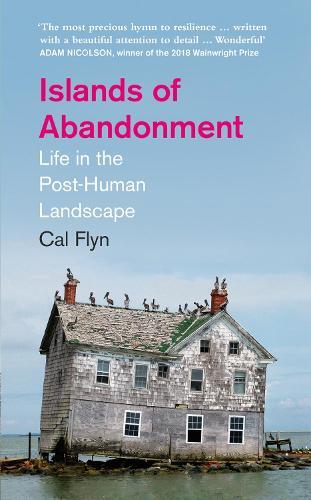
I’d say this was my favourite non-fiction book of this year. The intrepid Flynn journeys through the world’s eerie, abandoned spots, from Chernobyl to Detroit, and describes their mutant, post-human landscapes with a keen journalistic eye for detail. The book captures the strange beauty of ecological breakdown and the weirdness that can result…. from feral cows returning to their evolutionary roots on abandoned Scottish islands, to carginogenic crabs in the waters of New Jersey, to unique mosquito species that have evolved in the London Underground.
The Sunken Land Begins to Rise Again – M John Harrison (Gollancz, 2020)
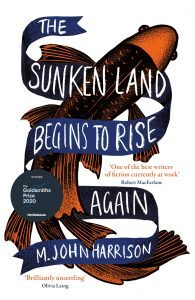
I can’t remember if I read this in 2021 or 2020, or if I dreamed the whole thing and it now resides in pools of memory in my subconscious, taking the form of a novel whenever I think about it. The story takes place both in the murky docklands of London and in rural Shropshire, where its middle aged protagonists catch glimpses of fish-like humans, who might be manifestations of deeply-embedded evolutionary DNA that have become reactivated, or intimations of a flooded future. Another sublime piece of weird fiction from the master.
Mrs Death Misses Death – Salena Godden (Canongate, 2021)
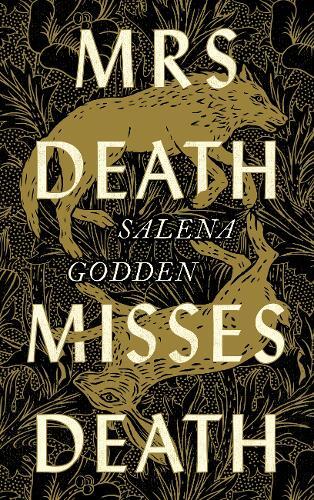
Wolf Willeford, an East London poet, is visited by Death – a black woman who shapeshifts through a multitude of identities, from a homeless beggar to a hospital worker to Nina Simone, exhausted by her role in the world’s many murders and tragedies, those past and those to come. Among its ruminations upon loss, there are some wonderful evocations of urban London landscapes and impassioned passages about the tragedy of the Grenfell Tower fire. Blending poetry, memoir and fiction, this book about death is surprisingly hopeful and uplifting.
Brittle with Relics – Richard King (Faber, to be published in 2022)
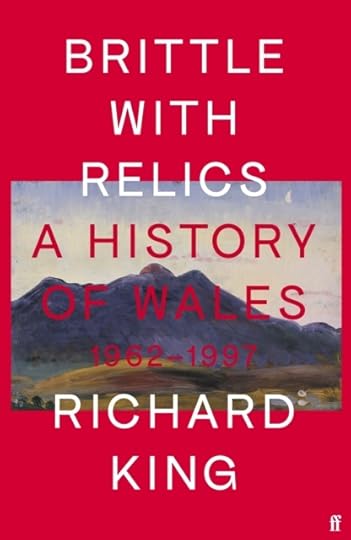
This book isn’t out until next year, but I was lucky enough to read an advance copy. It is a compelling oral history of Wales between the years of 1962 and 1997, a transformative period in which a struggle for language, culture and community was played out against a backdrop of industrial decline. This book tells the extraordinary tale of activism and resistance that led to the bilingual signs we take for granted on Welsh roads today.
Imperial Mud: the Fight for the Fens – James Boyce (Icon books, 2020)
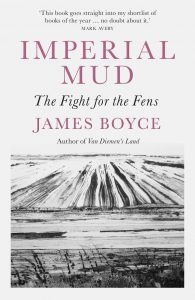
This is the story of a people’s struggle to hold onto their fertile, strange, intertidal world, against the invading forces of capitalism, colonialism and technology, which sought to drain and farm their land for profit. The result was that 99.9% of the original wetland has gone for ever, and the peat-stripped, dried-out remaining land has shrunk so much that it is seven metres below sea level in some places, leaving it one of Britain’s most vulnerable spots to future floods as a result of global warming.
These Towers will One Day Slip into the Sea – Gary Budden and Maxim Griffin (2021)
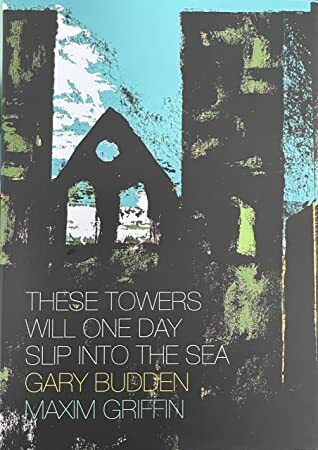
This short, collaborative work about the Reculver cliffs in Kent is a powerful elegy for a deeply layered landscape, where a ruined twelfth-century church sits on the site of a monastery, which is itself on the site of a Roman fort. Budden deftly describes a complex place that is in constant transition, accompanied by Maxim Griffin’s starkly layered, fracturing moodscapes.
Gigantic – Ashley Stokes (Unsung Stories, 2021)
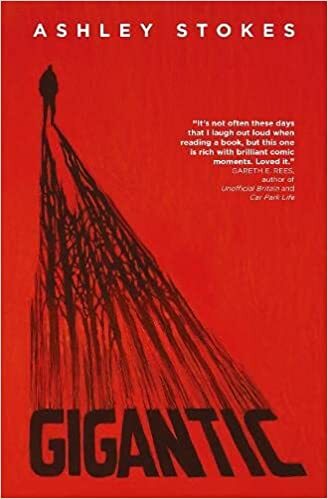
I liked Ashley Stokes’ novel about deluded bigfoot hunters in Surrey so much that I told the publisher what I thought about it, and then they put those thoughts on the front cover. Hark at me! What I said was this: “A very funny account of cryptozoological shenanigans on the edge of urban Banstead. It’s not often these days that I laugh out loud when reading a book, but this one is rich with brilliant comic moments. Loved it.” I stand by my statement. Go and read it!
Self Portrait In Green – Marie Ndiaye (Influx Press, 2021)
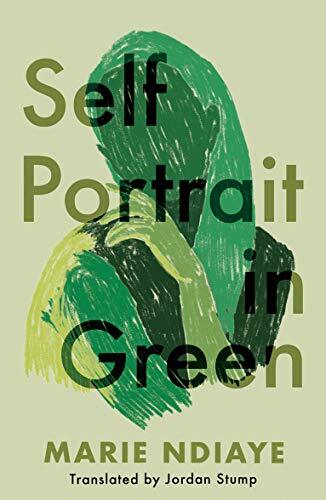
This enigmatic and puzzling French novella is a fractured portrait of an unreliable narrator, which brings to mind a cubist painting. The narrator is haunted by visions of a green woman, who takes on a myriad of familiar forms, from old friends to her mother, sisters and step-mother, all of whom might (or might not) be extensions of her own psyche. While this is not at a landscape book, Ndiaye is brilliant at mapping the shifting and uncertain geographies of the human psyche.
Book of Trespass – Nick Hayes (Bloomsbury 2020)
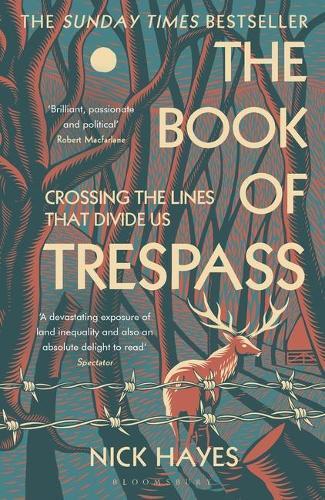
I was given this book as a gift last Christmas and it went instantly to the top of my TBR pile. Hayes explores the edges of Britain’s privatised land, making experimental forays into the forests and fields where we are not permitted. It’s an expose of how most of our isles are in the grip of vested interests, and a passionate rallying call for our right to roam.
Monolithic Undertow – Harry Sword (White Rabbit, 2021)
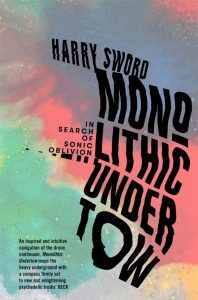
As a fan of Hawkwind, German experimental music from the 70s, and contemporary ambient soundscapers like Richard Skelton, this was an obvious must-read for me, Sword’s entertaining book traces the origins of drone to its Neolithic, archaeoacoustic beginnings, then follows its oscillating journey through popular music and culture. I spent a long time with this one, mainly because I kept hopping onto YouTube to listen to the music. Not that I need much of an excuse to do that.
Out of the Darkness – Ed. Dan Coxon (Unsung Stories, 2021)
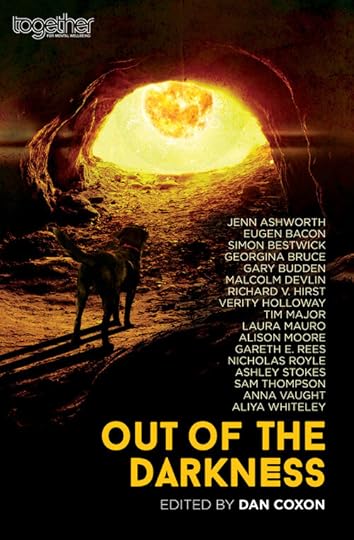
Full disclosure: I have a short story about a B&Q car park haunted by vampiric entities in this British anthology of weird fiction and horror. But the other tales are really good, so I’d encourage you to get a copy. The collection examines mental health issues through the lens of the uncanny and weird, without resorting to tired tropes (eg. psychologically disturbed person goes on a killing spree). All the proceeds go to a mental health charity.

ABOUT THE AUTHOR
Gareth E. Rees is author of Unofficial Britain (Elliott & Thompson, 2020) Car Park Life (Influx Press 2019), The Stone Tide (Influx Press, 2018) and Marshland (Influx Press, 2013).
Facebook Twitter LinkedInNovember 17, 2021
In Memoriam Ian Rawes: A Tribute to The London Sound Surveyor
WORDS: Ben Thompson
LOCATION: London’s Sonic Ether
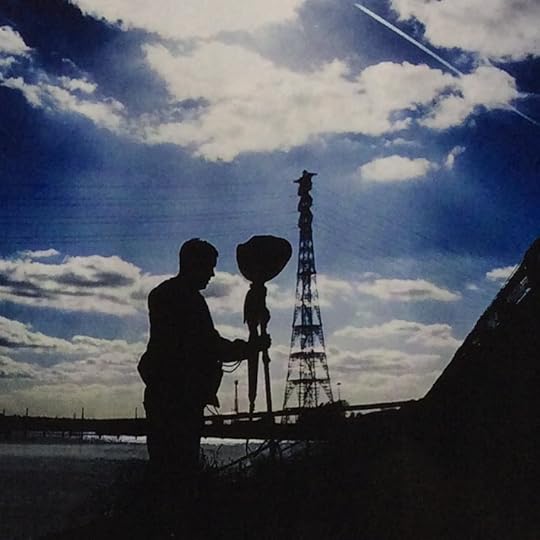
Ian M. Rawes, who died last month at the age of 56, was a major figure in the history of British field recordings. That formal-sounding achievement may conjure up a rather dry, academic image, but Rawes’ quixotic career path was actually illuminated by an infectious sense of mischief. Like Mark Fisher, whose line about “the solitary urinal of male subjectivity” he quotes with a chuckle in this hour long 2019 Resonance FM interview, (full tracklisting below), the enduring vitality of the work he left behind renders his early death all the more poignant.
The first time I met Ian was at the British Library in 2012. I was editing a book of Mary Whitehouse’s letters for Faber at the time, and in his capacity as (to use the title he rejoiced in) “vault keeper” of the National Sound Archive, he was kind enough to assist me in my search for punk songs that mentioned her. The innocent enjoyment Ian seemed to take in delivering copies of albums by The Adicts and Sore Throat to the library’s exquisitely stylised listening environment makes more sense now I know of his pre-history as a noted firebrand in the already fiery realm of direct action anarcho-punk fanzines (see this fond and detailed tribute by John Cooper for further info).
In-between helping me work out which of the 103 tracks on Sore Throat’s landmark 1989 album Disgrace to the Corpse of Sid was “Mary Whitehouse Raving Mad” (it’s actually track 87 on side one), Ian told me about his extra-curricular activities with the London Sound Survey.
In a career arc that will be familiar to students of the great Victorian naturalists, this Herculean field-recording endeavour spiralled in subsequent years from a hobby into a life’s work, creating an archive (London Sound Survey) whose institutional grandeur is commemorated in this unusually authoritative and fair-minded (for that newspaper) tribute in the London Evening Standard.
We kept in touch, and by the second time I met Ian – his first appearance on my Resonance 104.4FM show The London Ear (no doubt lurking somewhere in the archive but I’ve not been able to track it down yet) – he had released a fantastic compilation of these field recordings (2013’s Vittelli records release These Are The Good Times) and was in the process of overseeing a unique concert in the bascule chamber of Tower Bridge, where he’d been allowed to record the sound of the bridge opening, only to be delighted by the process wherein this recording was reconstituted as a live event by aptly-named composer Iain Chambers. Listen here.
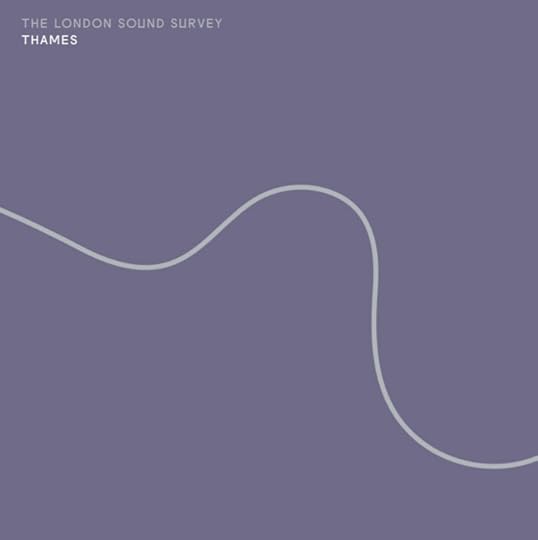
At Resonance, Ian was quite properly revered as a Hindu God. And for his next – and, sadly, -as it turned out, last – appearance on The London Ear, a show to whose title he may justly have laid claim to as a soubriquet (linked above) he wore a fancy hat quite in keeping with his enhanced status. Having relocated to the digital hub of Cambridge, he talked affectionately of the skunk farms and brothels now populating the new-build developments around his new home (his experiences of these were not as a punter but rather from a part-time job delivering junk mail) and introduced his new album of Thames estuary recordings on the Persistence of Sound label.
Listening back to this show again, after Ian’s death, I found it very moving how detailed and humorous an account he gave in it of the evolution of his appreciation of sound – from the urban resonance of tall buildings flanking narrow streets in his inner city upbringing, to the wide-open spaces of vanishing tracts of post-industrial estuary wilderness, via teenage immersion in the dramatic sound-stages of Joy Division and PIL (not to mention Bauhaus). It was a beautiful journey, and it’s very sad that its ultimate destination arrived too soon.
Track-listing of May 2019 Resonance FM interview with Ian M. Rawes
Thames Albert Basin
Elvin Jones – drums from Africa Brass
Thames All Hallows’ Marshes (by day)
Rockers Revenge featuring Donnie Calvin – Rocking on Sunshine (excerpt)
Coryton Refinery Siren
Penderecki – Cosmogonia
Steven Feld – The Time of Bells
Pilgrimage to Santiago Sanctus
Thames – Machine Room (Tower Bridge Lifting)
ABOUT THE AUTHOR

Ben Thompson is an author and music journalist who presents The London Ear at noon every Thursday on Resonance FM.
Facebook Twitter LinkedInOctober 19, 2021
Humming Towers: The Allure of Electricity Pylons
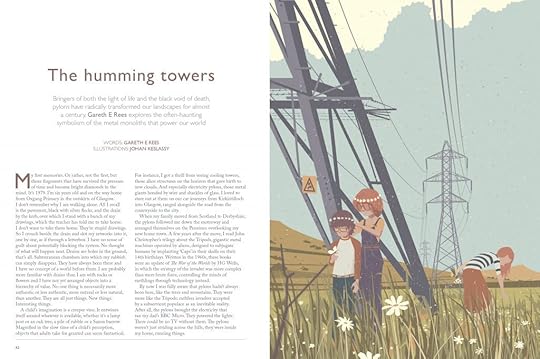
Words: Gareth E. Rees
The latest issue of Ernest Journal is out now. It features an edited extract from Unofficial Britain, with some wonderfully evocative illustrations by Johan Keslassy.
Back in 2008, I began wandering the Hackney and Walthamstow Marshes with my cocker spaniel, trying to escape the demands of life as a new father. I became obsessed with taking photos of one of the electricity pylons, which stood apart from the others in the Middlesex filter beds, a Victorian ruin repurposed as a nature reserve.
When I started my blog The Marshman Chronicles in 2011, the pylon featured in an early post, and became the focus of my short story, ‘A Dream Life of Hackney Marshes’, in which the protagonist begins a romantic affair with the structure. This led to my first book deal with Influx Press (Marshland, 2013) so you could say that it was the pylon which got the creative ball rolling for me.
Ten years, four books and many short stories later, my thoughts on the strange allure of pylons are featured in the latest issue of Ernest, which you can order here and read at your leisure – for instance, in your living room, a snazzy café, or on your prison bunk bed.
It’s an edited extract of my book, Unofficial Britain (Elliott & Thompson, 2020), but enhanced with specially commissioned illustrations by Johan Keslassy. It’s a magical thing to see an artist’s interpretation of your work and I’m really pleased with the results.
I share issue 11 of the Ernest journal with plenty more good stuff about place, travel and curious histories, including the healing waters of the Westfjords…. Java’s volcanic rituals and industry… nature and artifice on St Kilda… a new era of bio-design… Hvaldmir the Russian spy whale… and seeking the wild west in the wild east.
Go and check it out – you won’t be sorry! Ernest Journal.
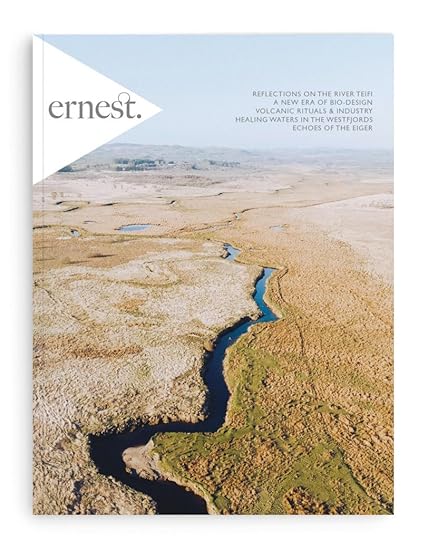

ABOUT THE AUTHOR
Gareth E. Rees is author of Unofficial Britain (Elliott & Thompson, 2020) Car Park Life (Influx Press 2019), The Stone Tide (Influx Press, 2018) and Marshland (Influx Press, 2013).
Facebook Twitter LinkedInAugust 22, 2021
Occult Lampposts
WORDS & PICTURES: Gareth E. Rees
LOCATION: A street near you
The smooth metal surfaces of Britain’s streetlights are a prime canvas for graffiti, coded messages and promotional stickers. Spread out at regular intervals in densely populated urban areas and illuminated at night, they are an ideal medium for conspiracy theorists, artists, musicians and local kids expressing their latest beef.
If we broaden the definition of ‘occult’ to include its original meaning, “clandestine, hidden, secret”, then lampposts can be viewed as an unofficial channel of covert ‘dark’ communication. Often these messages are creepy, weird and horrific.
Take this one below, daubed in the number of the beast. The same person repeated this across all of the lampposts in this one road in Hastings, a notorious hub for occultists and the town in which Crowley died (and allegedly cursed).
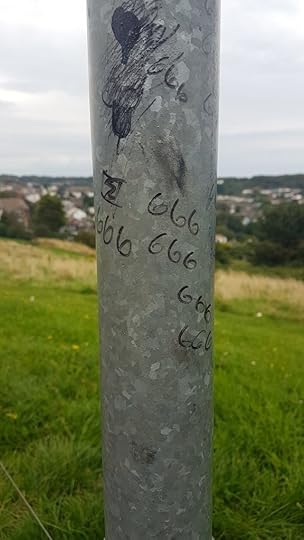
Or this one, referencing the ‘killer clown’, John Wayne Gacy who murdered 33 young men and boys in Chicago during the 1970s.
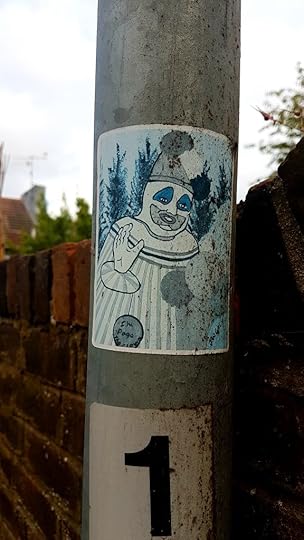
Meanwhile in Bristol – They Live!
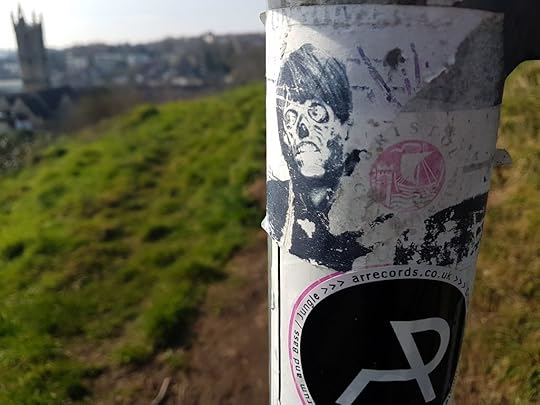
This one is truly sinister- a plastic bottle stuffed with crow feathers. What does it mean? Who is this for?
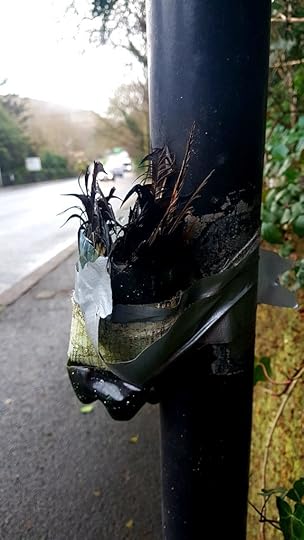
Below, you’ll see a slightly sparkling punk band sharing space with a Bill Gates Covid vaccine conspiracy theory (technically a traffic light not a lamppost, but you get my drift).
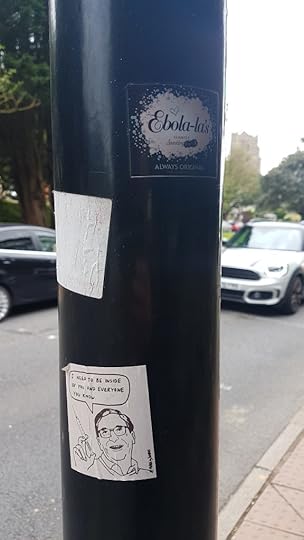
More conspiracy!
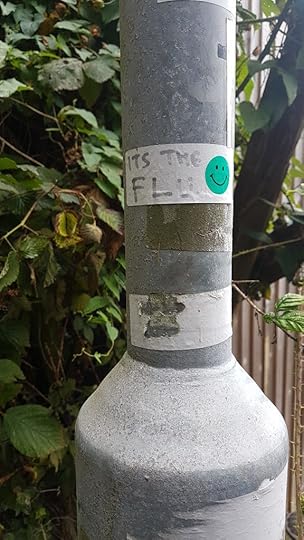
Owls are a common symbol of wisdom, knowledge and intelligence…
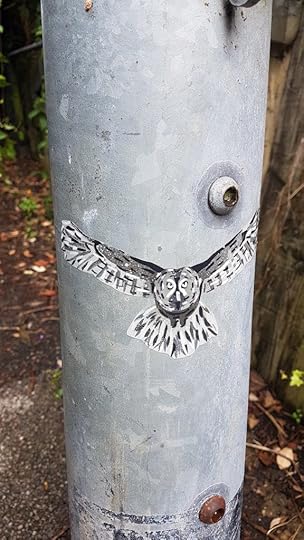
The demon approaches…
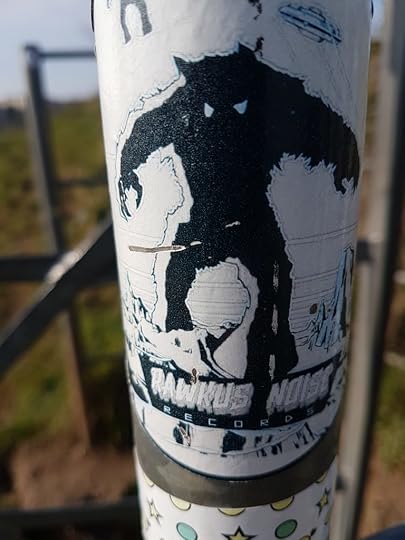
I think the subliminal message here is DO take drugs. Drugs are great.
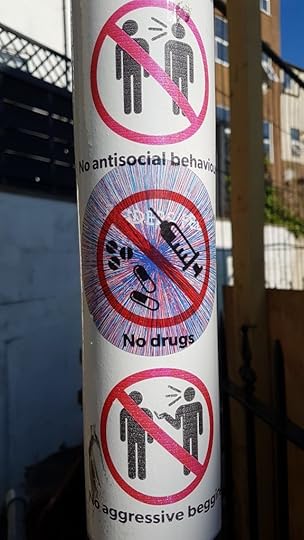
Decaying skull, consumed by rust.
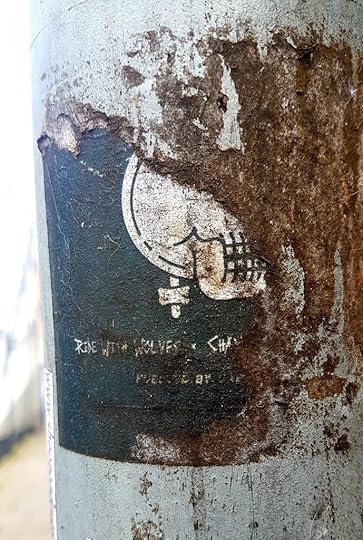
The black cat with demonic red eyes HATES Nazis and so should we all. FIGHT BACK!
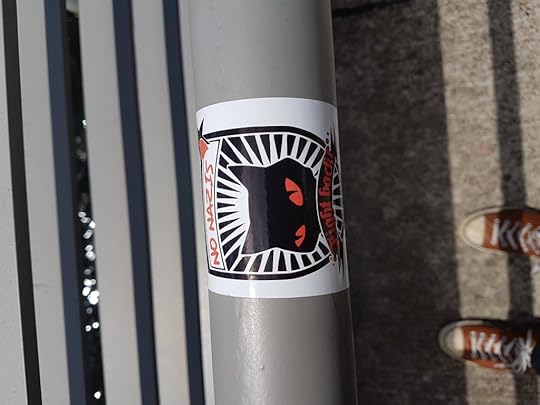
For more of my weird trips through everyday urban spaces, check out my book UNOFFICIAL BRITAIN; JOURNEYS THROUGH UNEXPECTED PLACES
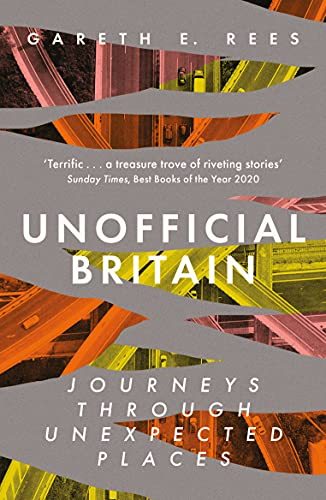

ABOUT THE AUTHOR
Gareth E. Rees is author of Unofficial Britain (Elliott & Thompson, 2020) Car Park Life (Influx Press 2019), The Stone Tide (Influx Press, 2018) and Marshland (Influx Press, 2013).
Facebook Twitter LinkedInAugust 7, 2021
Unearthing Sacred Narratives: Bede’s Walk
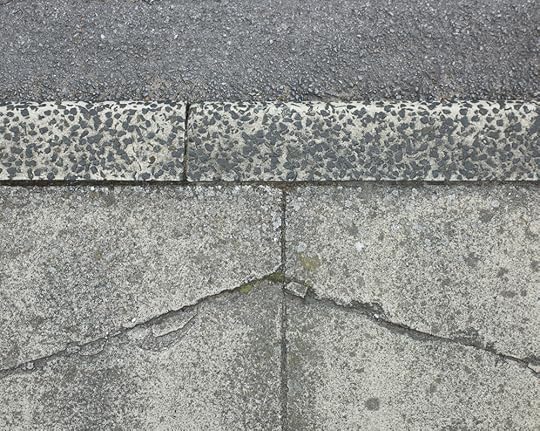
WORDS & PICTURES: Mark Adams – from his project Peregrinus – Bede’s Walk
The images in ‘Peregrinus – Bede’s Walk’ depict a series of walks along Bede’s Way, an historical path in the north east of England which runs between two Anglo-Saxon monastic sites – St Peter’s in Monkwearmouth, and St Paul’s church in Jarrow.
Pilgrims initially undertook this route in the 7th century, paying homage to the Venerable Bede, an Anglo Saxon scholar noted as the father of English history. Today, Bede’s Way is a sign-posted cultural and heritage route, which embodies nature, history, religion and tourism.
This project combines photography and GPS tracing of the walk, overwriting the path of the pilgrim’s way using cameras and contemporary technology. This represents both an experiential and an indexical notation of the walks by using traditional Cartesian perspective and aerial non-perspectival modes of image making. The unification of the material and immaterial is characteristic of the traditional pilgrimage, an instrument of contemplation of relationships between the sacred and the secular, and a central theme of this project.
Like all contemporary pilgrimages these journeys follow an historical precedent – to trace the footsteps of ancestors, embodying history through a disciplined process of repetitive, sustained walking. Looking down at the floor at tactile surfaces, pavements, grass and dirt tracks describes the walk as it progresses but alludes to the gaze from above, the authority of technology, a God’s eye aerial perspective and the language of cartography.
The result is a multi dimensional experience, finding relationships between the devotional activities of the pilgrim and the detached observations of the psychogeographer looking for hidden meanings in the quotidian, unearthing sacred narratives found in the topographic features of the landscape.
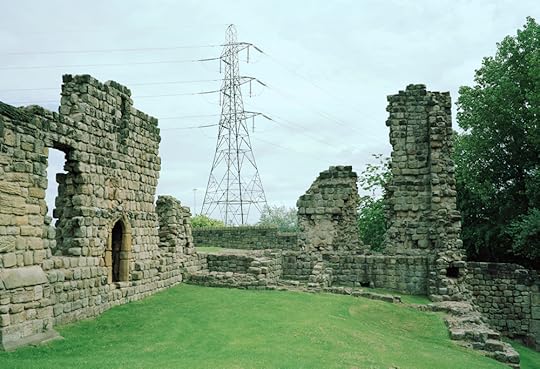
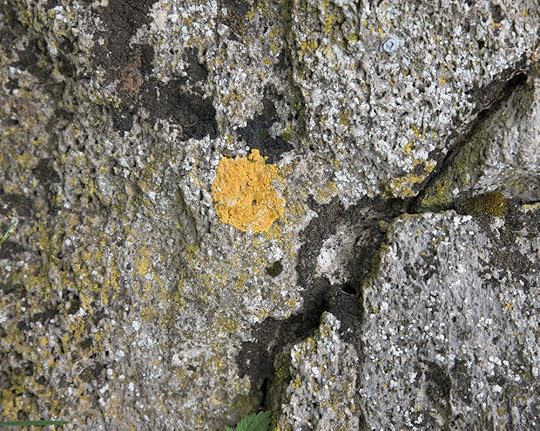
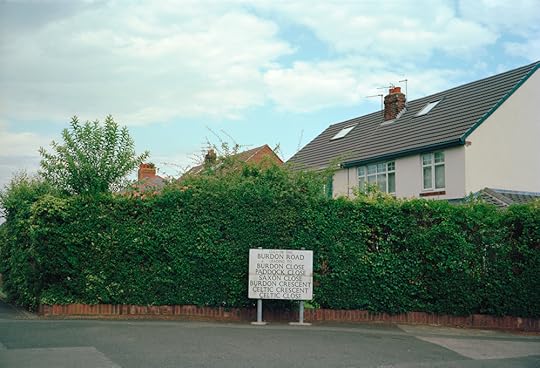
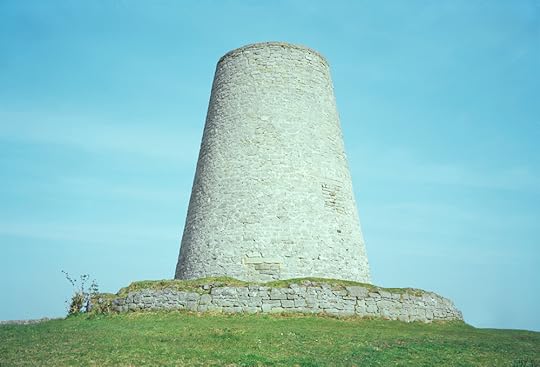
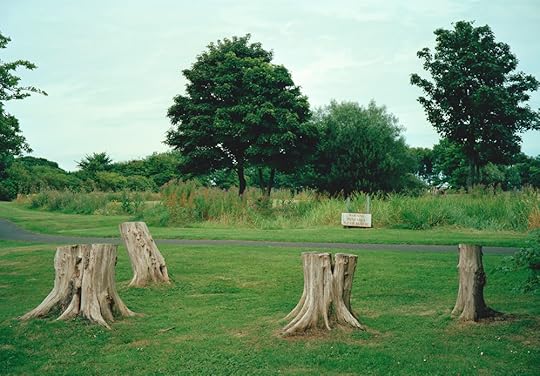
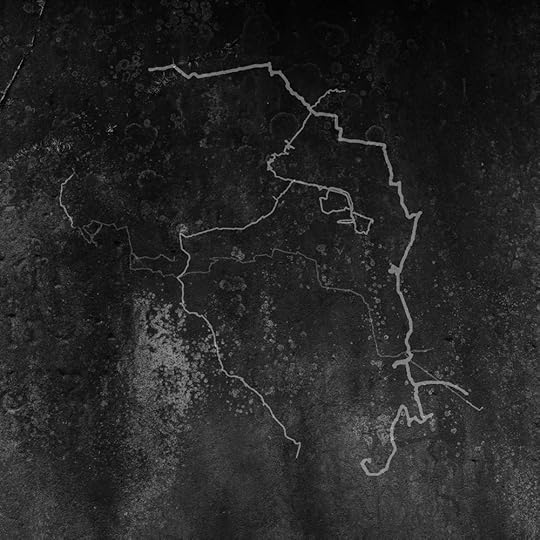
ABOUT THE ARTIST

Mark Adams is a photographer whose practice is concerned with landscape representation. You can see more from Peregrinus on his website here. You can also follow him on Instagram.
Facebook Twitter LinkedInJune 28, 2021
Echtrai – the Secrets of Lost, Abandoned & Mythic Landscapes
WORDS: Gareth E. Rees interviews Baz Nichols.
Echtrai is a new journal of writing and art dedicated to lost, abandoned and mythic landscapes. It features work by Dominic Cooper, Louise Kenward, Cal Flyn, Emily Hesse, Jeff Young, Nick Pepper, Laura Harrington, Alex Woodcock, Jon Woolcott, Brighid Black, Dr Lizzie Fisher, Martyn Hudson and Deborah Westmancoat. I got in touch with its founder and editor, Baz Nichols, (who also contributes under the pen name, Bran Graeme Nairne) to find out more.
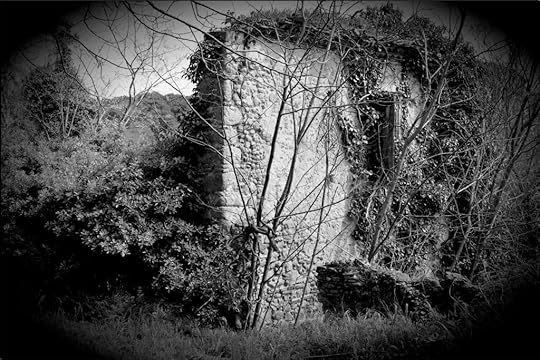 Photo: Chat Robinson
Photo: Chat Robinson Gareth E. Rees: Congratulations on the pilot edition of Echtrai. It looks gorgeous. Let’s start with the title – can you briefly explain a bit about the term ‘Echtrai’?
Baz Nichols: I discovered the word Echtrai whilst researching Celtic mythology, a passion of mine. Very briefly, an Echtrai is an odyssey, a mythic journey into the unknown of the Otherworld in Irish mythology. Whilst searching for an appropriate title for the journal, this word seemed to cling, it felt right for the journeys we undertake as writers, and also chimed with the themes that we had set down for the journal itself.
GER: What inspired you to create a journal on the subject of lost landscapes? Does this subject have any links with our contemporary crises?
BN: I have been self publishing small editions of my writing and art seriously since early 2010. I began writing about marginalised landscapes after accidentally discovering an old 12th century church near my (then) home in rural Northamptonshire, and I was inspired to research its history, and began to accumulate a body of writings and incantations based around that.
Going deeper, I was born and brought up in East London in an area that straddled both the city and the rural edgelands of Essex and Hertfordshire. During my formative years, London was still very much in recovery after WW2, it stilled carried with it some of that trauma, and that had a profound affect on everyone living there at the time. My youth was very largely spent exploring these ‘lost zones’, dowsing and absorbing this curious admix of rural wildness and the abandoned factories and wastelands, which obviously had an impact on me psychologically and creatively.
During the Covid pandemic last year, I had time to connect seriously with other like-minded writers and artists that I felt had the quality and literary skill to produce something that had some creative resonance. I think you’re right – the journal very much came about at a time of national crisis, not only in terms of the pandemic, but also a raised awareness of our impact on our climate and ecosystem, and how all of that combined might potentially make us complicit in our own demise as a species.
The British coastline in particular is in rapid transition as sea levels are rising, and the rate of coastal erosion is currently quite alarming. I believe that our knowledge of that makes it all the more urgent that we not only act quickly to avoid a cataclysm, but also start to collectively record and document these places and their stories before they are lost to history.
I really feel deeply that there is a groundswell of interest in the landscapes we have lost, or are losing, and I hope that in some ways the journal addresses this and raises greater awareness of these issues. My overarching ambition is that our name becomes synonymous with landscapes of loss, and that we can re-enchant, and re-mythologise these places as an act of both commemoration and preservation.
GER: You have a piece in the journal about Eynhallow, in the Orkneys. Back in 2017, we posted one of your pieces, Lost British Landscapes, on Unofficial Britain. It looked at Doggerland, the former land bridge between the east of England and Europe. What interests you in particular, as a writer, about submerged places?
BN: Overall, I do have this odd passion for landscapes of loss, or those places that have slipped between the cracks of history. I think for me, it has roots in our collective memory, those lost narratives, or forgotten and abandoned places that once had cultural value or some central significance in society, which for whatever reason then dissolves or evaporates from external pressure of war, disease, societal collapse, or a variety of other reasons.
Doggerland has particular fascination for me as it is a place that may still hold many secrets, submerged as it is, deep under the North Sea. Archaeologically speaking, it is relatively pristine, but over the years, deep dredging and oil pipeline activity has upset and fragmented some of its artefacts which have been dredged up for over a century now, and so its history has almost certainly become muddled and disarticulated.
Submerged or deluged lands have a central place in almost every country’s mythology and consciousness, and this has a fascination for me as it is a powerful theme that still resonates with us.
Again, I believe that floods and deluge are hard-wired deeply into our collective psyche, and that is probably an echo from a post-Ice Age mentality – it has tangible links with trauma and survival. There is also the enticing possibility that submerged places will reveal elements of our history previously unknown to us. Even as we speak, there is massive glacial retreat at the ice caps and beyond, and artefacts are appearing in landscapes that we had not realised were occupied by humans more than 30,000 years ago.
I wrote about Eynhallow under a pen name, and again, this island and the wider Orkney group once enjoyed greater status, and modern archaeologists have suggested that the area may have once been an ancient capital of Britain. This theory completely inverts our notions of sovereignty, and a London-centric view of our little island, as the Orkney islands may once have been a powerful cultural influencer, far removed from any city on the mainland. It is a compelling notion, and one that has rich thematic territory for me as a writer.
GER: Echtrai mixes non-fiction with fiction and poetry – it’s a blend I use myself in most of my books to get across both how a landscape feels, and how a landscape is as much a story as it is a physical entity. What appealed to you about this mixture in relation to the subject of lost and abandoned places?
BN: We wanted as much as possible to explore marginalised landscapes in more creative and interesting ways. I particularly wanted to challenge the more orthodox approaches to landscape writing, and bringing together a variety of authors from the academic to the experimental, to the poetic enables us to have a broader voice, and a wider perspective, and this in turn will have a greater appeal and crossover potential, exposing the reader to work that perhaps they may never have seen before.
We all experience and read or ‘decode’ the landscape in a variety of ways, and no two people will feel the same way about the places they have encountered. I think that is what makes it interesting. From a personal perspective, I write my more incantatory pieces based upon a deep spiritual connection with the many voices of the land itself, and the net result of that is a kind of hybrid of historic fact, and an idiosyncratic romanticism that fuses into something that is hopefully engaging and interesting to read.
I like that you mentioned how a landscape ‘feels’ – it is one of those intangible, ineffable forces that is almost impossible to articulate, yet as creatives, we are endlessly compelled to explore.
For future editions of Echtrai, I hope that we attract brave and innovative writers and artists and have their work and voices heard by a wider audience. Having a background in the visual arts, I have always been interested in the work of visual artists, and how they interpret marginalised places, and we have some very interesting and exciting work coming in as we speak.
To get a copy of Echtrai, click here.
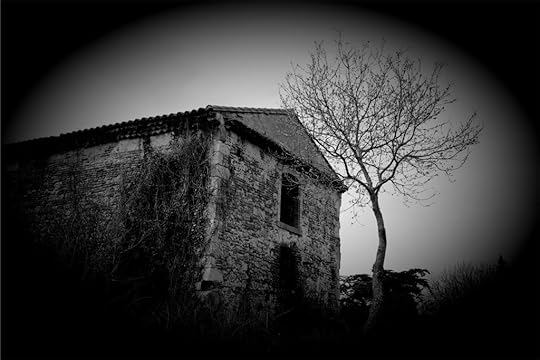 Photo : Chat Robinson Facebook Twitter LinkedIn
Photo : Chat Robinson Facebook Twitter LinkedIn
June 7, 2021
Alternative Soundtracks to a Luxury Apartments Advert
LOCATION: Deansgate, Manchester
The experimental music label Front & Follow has long been a firm favourite at Unofficial Britain, with many of their releases exploring landscape and evoking curious atmospheres.
Their latest compilation, You Can Nevcr Leave, is a riff on an advert for new luxury apartments in Deansgate, Manchester, featuring 31 artists including Field Lines Cartographer, Elizabeth Joan Kelly, Her Majesty’s Coroner for Wirral, The Leaf Library, Polypores, Hattie Cooke and more.
The original advert for the Deansgate Sq. flats is quite astonishing, as you’ll see below. The only thing missing is a bit at the end where the buff couple return to the apartment and light up a Gwyneth Paltrow cludge candle, before the man gets out a chainsaw and begins chasing the woman around the room to the Front & Follow soundtrack, laughing maniacally.
You can stream some of the album’s tracks or download the whole thing from here: You Can Never Leave. Proceeds from the sales will go to Coffee4Craig, which provides support for Manchester’s homeless.
Facebook Twitter LinkedIn
May 17, 2021
From Tarmac to Towpath: Excursions into Lockdown
From Tarmac to Towpath: Excursions into Lockdown is a new book from ChomaEditions, with text and images from 13 artists/writers across the UK, including Joanna Pocock and Clare Archibald. It includes spectral walks, psychogeographical encounters, eerie geometries, deserted towpaths, discarded masks and ghostly enclaves.
Here is an extract from the book: Neil Jackson’s piece, entitled ‘Catalogue of Lockdown’
CATALOGUE OF LOCKDOWN
November 2020
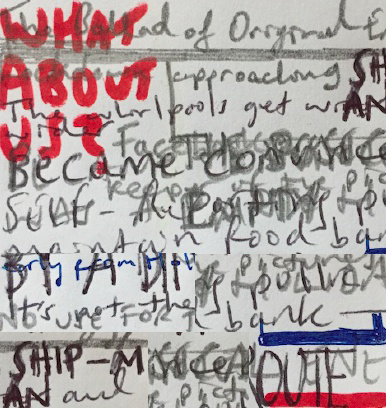
Items are offered subject to prior sale. We ask that payments from abroad are made in sterling, and cheques drawn on a UK bank, or they will be subject to a conversion charge. Postage is charged extra. New customers are asked to pay in advance. Images are available upon request. We are interested in buying items similar to our stock listed here, and in anything unusual not suggested by our catalogue. We issue two catalogues per year, in May and November.
1. EMPTY BUS. Clearance of road traffic and general public enables unhindered, self-perpetuating operation of local transport timetable. Refer to Magnus Mills “The Scheme For Full Employment” (2003) and “The Maintenance Of Headway” (2009). £25
2. BEER GARDEN. Would all people who want vegetarian burgers go on the left, and those who want meat burgers on the right. Refer to “Bonkers In Phoenix” – THE FALL. Letting dust inside old swings turning to rust. Item includes a quote from Brix Smith. “Mark obliterated the song, in my opinion. He put the most ugly, vile noises on it, and drowned out any of the delicacy.” £11
3. LIDL. Alpha male seeks bulk pasta lockdown security in popular supermarket. Orwellian voices guide consumers in a clockwise direction. £8
4. BANK HOLIDAY. Location: Regents Park, London. Reserved days are now inseparable from standard weekdays. Relates to the unseen “Dawson in Soho 1989-1993”. Dawson said he wanted to climb up Primrose Hill and drink wine. The streets were noiseless, bright and sunny. People seemed cheerful. I became convinced it must have been a bank holiday. Afterwards we went on in the direction of Marylebone. Dawson started talking about the Post Office Tower and how it seemed to be following us across the pathways. £4
5. SHIPMAN. Polarised trust/distrust of televised state medical advisers recalls for many the British doctor convicted of administering lethal doses of morphine to his patients, mostly elderly women. Refer to “What About Us?” – THE FALL. Item includes partial transcription of a discussion between Fall singer and lyricist Mark E Smith and the author Michael Smith. MS: I’m thinking of a song like ‘What About Us’, which seems to be about an East German rabbit that comes to Manchester as an immigrant and is happy until the day it finds out that Harold Shipman has been giving out drugs to old ladies. MES: Did you actually think it was about a rabbit? £10
6. HIGH STREET PAINT ARROW. Relic of futile mid-2020 drive to divide High Street into distinct upstream and downstream pedestrian channels. £35
7. ORIGINAL ENERGY. Flattened cans of Dutch energy drink unavailable in shops yet oft-seen on heat trudge loops. Refer to Neil Jackson “Dawson in Wonderland” (2017). The letter also discussed an addiction to a soft drink called Original Energy, which, I was to find, he could produce by magic from his coat pocket to guzzle at will. I recognised the red and silver cans as part of a tidal flow of rubbish that lapped into the doorway of the offices of my ex-employer. £4

8. HINTERLAND. In German, “the land behind”. Can be used for vague locations of ill-defined urbanity. Exposure to liminal areas and paradigms of hinterland could increase during times of lockdown. Refer to Iain Sinclair “London Orbital” (2002). Consideration of Sinclair’s report on indeterminate space is recommended. Refer also to “Hinterland” – LONELADY. £20
9. FALSE HORDES. Overdubbed crowd noise for televisual enhancement of empty-stadium football matches has resulted in philosophical quantum theory confusion. Can the tangible players hear the illusory crowd? “Reality is merely an illusion,” Einstein once admitted, “albeit a very persistent one.” £14
10. MUSEUM OF LONELINESS. Experience becomes its own form of curating drifted into cultural margins. Refer to Chris Petit “GOOGLEmeGOD” (2013). £30
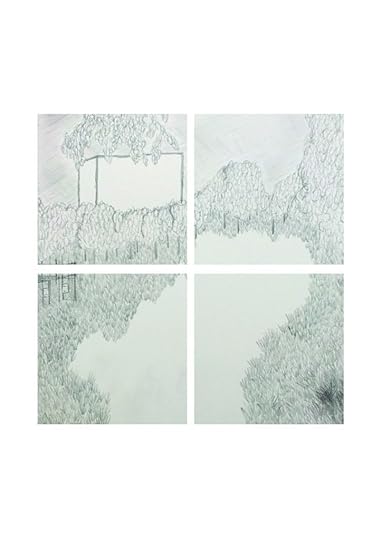
ABOUT THE AUTHOR
Neil Jackson is a writer and publisher living in Newcastle-upon-Tyne and is the creator of the Post-Nearly Press conversations series, featuring Iain Sinclair, Chris Petit, Andrew Kötting, Alan Moore and Stewart Lee. His short, ambient fiction, Dawson in Wonderland is published by Voices in a Lane, and he remains a regular contributor to the long-standing journal of English culture, Albion Magazine Online.
You can view the film that accompanies from Tarmac to Towpath below – and read more about it here.
Facebook Twitter LinkedIn


